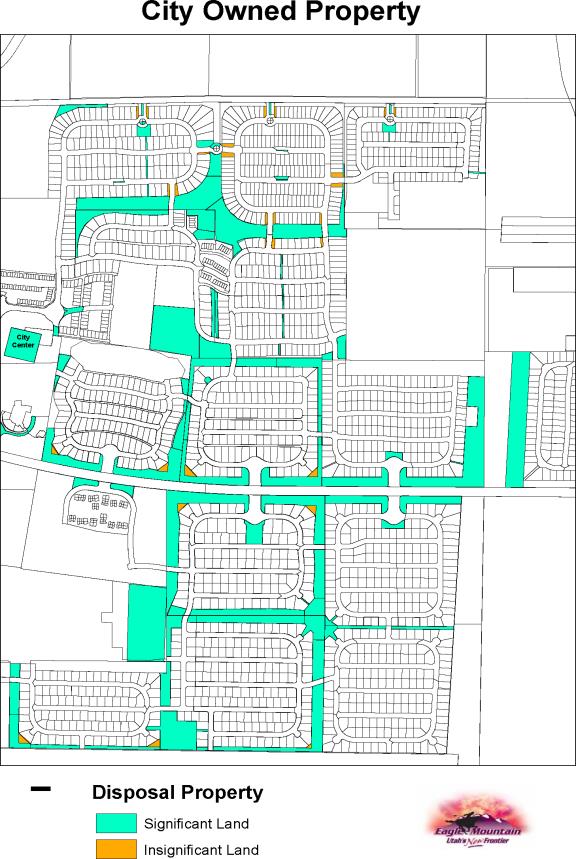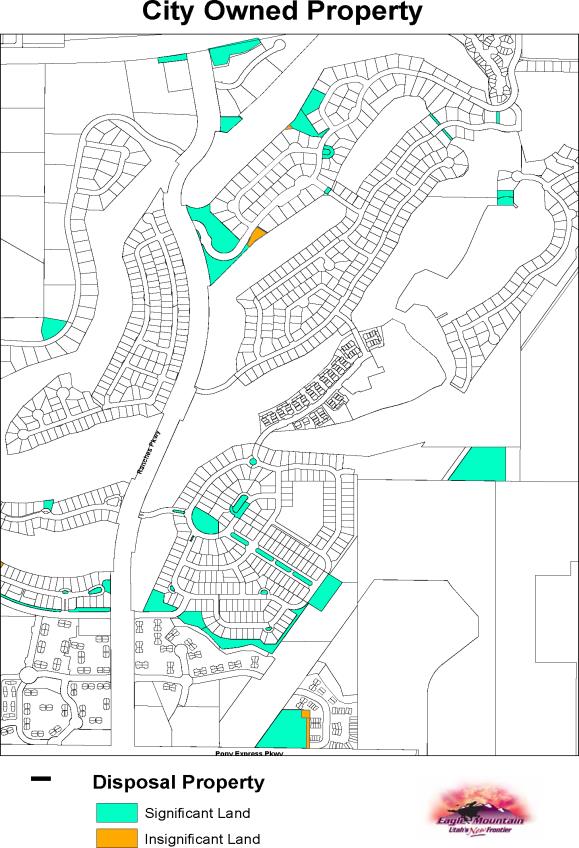Chapter 3.30
DISPOSAL OF CITY REAL PROPERTY
Sections:
3.30.010 Classification of lands.
3.30.020 Land disposal application.
3.30.030 Decision on application.
3.30.040 Definition of disposal or disposition.
3.30.060 Significant land disposal.
Prior legislation: Ords. O-11-2003 and O-05-2007.
3.30.010 Classification of lands.
The city hereby approves and adopts the land classification maps which are Exhibit 3 of the ordinance codified in this chapter; the land area designated as “Significant Land” defines city-owned land that will not be considered for disposal without an affirmative vote of the city council as provided in EMCC 3.30.060. The land areas identified on Exhibit 3 as “Insignificant Land” show city-owned land available for disposal.
A. For future classification purposes, the lands meeting the following criteria are considered “Significant Land”:
1. Lands that have a national, regional, or local historic feature, which may include but is not limited to: land classified upon its acquisition or thereafter by the city as viewsheds or viewpoints, outdoor classrooms, and/or scenic and historic corridors. An example of the land that will be dedicated to the city as historically significant land is the Pony Express Trail corridor.
2. Lands that have an ecological feature not susceptible of economically reasonable mitigation, which may include, but are not limited to, lands with: excessively steep slopes (over 25 percent), water quality protection features, drainage corridors, significant geologic features, land classified upon acquisition or thereafter by the city as important wildlife habitat and/or vegetation important to erosion control. An example of the land that will be dedicated to the city in this category is Tickville Wash.
3. Lands that are the site of city activities such as active fire stations, City Hall, shops, utility facilities, development-oriented open space which may include but are not limited to: required development code commercial buffers, park strips, entryway features, infrastructure and capital facilities, roads, trails and rights-of-way.
4. Lands that have a recreational feature which may include, but are not limited to, recreational facilities, trails, semi-improved natural areas, neighborhood parks, community parks, and regional parks.
B. For future classification purposes, city property considered “Insignificant Land” will have one or more of the following attributes:
1. An easement or right-of-way that is located in a place that will not be used for an easement or right-of-way and no public facilities, roads or utilities are foreseeable using the easement or right-of-way.
2. Unless mapped as “Insignificant Land” on Exhibit 3, unimproved isolated parcel(s) or a remnant parcel surrounded by development and not received originally as viewshed, required buffer or required open space.
3. The city has no plans or reasonable anticipation for improving the parcel.
4. The parcel is not defined as having cultural or ecological significance.
5. Except for land mapped as “Insignificant Land” on Exhibit 3, the disposal of the land will not cause a violation of the standards in the development code by surrounding or adjacent lands or fragment or subdivide an existing parcel.
6. The parcel no longer serves a public purpose or the purpose that was originally intended for the land is not viable.
7. Except for land mapped as “Insignificant Land” on Exhibit 3, the land constitutes an entire contiguous parcel.


[Ord. O-11-2009 § 1; Ord. O-03-2009 § 1].
3.30.020 Land disposal application.
A request for the disposal of land owned by the city shall be initiated by submitting a complete land disposal application to the city recorder (see Exhibit 2 of the ordinance codified in this chapter). The application shall state whether the land is mapped as “Significant Land” or “Insignificant Land” and state the name and address of the applicant, the real property subject to the request for disposal with reasonable certainty and contain a map or sketch of the property identifying its dimensions, acreage, or gross square foot total, and location within the city. If the land is mapped as “Insignificant Land,” the application shall include a survey of the parcel subject to the application and a copy of the lot plat of the applicant’s adjacent lot. The applicant must be an adjacent land owner and is responsible for gathering all required application materials. Where applicable, any disposition of city property that creates additional parcel(s) shall be required to consolidate any and all separate parcels into the applicant’s original adjoining property to eliminate random isolated parcels.
A. No application proposals shall be processed without all required supporting application materials required by this chapter.
B. The city recorder shall evaluate the proposal and determine whether or not the property subject to the proposal for disposition is mapped and qualified as “Significant Land” of the city or pre-approved by this chapter as “Insignificant Land” and shall provide written notice of the application to each record owner of land adjoining the parcel described in the application at the address on file in the city offices, at other owner-requested notice addresses if any, or in the office of the Utah County treasurer. If the application is for disposal of “Insignificant Land,” the notice shall state that the application will be considered favorably unless an adjacent owner or the applicant objects to the proposed disposal in writing within 10 days of the mailing date of the notice of the application.
C. The city recorder shall present each application for “Insignificant Land” as designated on Exhibit 3 of the ordinance codified in this chapter together with any objections to the application received by the city recorder with a formal recommendation to the mayor or designee for approval, approval with modifications or disapproval. The city recorder’s formal recommendations shall include the proposed valuation of the property for payment to the city and a recommendation as to whether the application should be granted, modified to accommodate concerns of adjoining owners or denied. The valuation of the property for disposal should be calculated based on the average per acre value of unimproved agricultural land on the records of the Utah County recorder located within a five-mile radius of the land proposed for disposal.
D. The city recorder shall notify the applicant for disposition of the property and each party objecting to the application and provide the applicant and objecting property owners with an opportunity to appear before the mayor or the mayor’s designee and present the position of the interested parties with respect to the disposition of the subject property. [Ord. O-03-2009 § 2].
3.30.030 Decision on application.
Upon receipt of the recommendation from the city recorder in favor of or in opposition to the disposition of the property and after notice as required by this chapter, the mayor or the mayor’s designee shall act on the application for disposal. If the mayor or designee approves the application for disposal, the city recorder shall proceed with the transfer of the property as approved. If the mayor or designee does not approve the application, the applicant and other interested parties shall be promptly notified of the action. The mayor shall notify the city council members of each action taken to approve or disapprove an application for disposal of public land.
A. Appeal of Decision. The applicant, and any landowner adjacent to the parcel proposed for disposition or other interested party appearing before the mayor prior to the mayor’s decision on the application, may appeal the mayor’s decision to the city council by filing a notice of appeal in writing with the city recorder not later than 30 days after the date of the notice of the mayor’s action required in this section. Each notice of appeal shall be in writing and shall state the reasons why the party appealing the action (the “appellant”) believes the action by the mayor violated the terms or intent of this chapter.
B. Hearing on Appeal. The city council shall place the notice of appeal on the next regularly scheduled meeting agenda of the city council and shall consider a presentation by the appellant on the grounds and reasons for the appeal and by the original applicant or other members of the public, and review the actions of the mayor which are the subject of the appeal. The council may affirm or reverse the decision of the mayor or consider and approve a motion to direct the mayor to reconsider the application with specific findings concerning the matters for reconsideration as found by the city council.
C. Re-Appeal of Decision. A party who qualified as an appellant in the initial action of the mayor on a land disposal matter which was appealed to the city council may appeal any subsequent decision of the mayor with respect to the same land parcel; provided, however, that if a second appeal to a decision of the mayor is taken, the decision on the second appeal shall be final and no further appeal shall be considered by the city council. [Ord. O-03-2009 § 3].
3.30.040 Definition of disposal or disposition.
As used in this chapter, the term “disposition of city property” shall mean the transfer of control of city-owned property to another by any means including, but not limited to, sale, lease or other type of conveyance of such property. [Ord. O-03-2009 § 4].
3.30.050 Payment.
Every disposition of city property shall require the payment to the city of a sum equal to the estimated fair value of the property calculated by the city recorder as set forth in EMCC 3.30.020(C) or other current appraisal authority in considering the fair value of the property. [Ord. O-03-2009 § 5].
3.30.060 Significant land disposal.
Any person wishing to purchase a parcel of “significant real property” may submit an application to the office of the city recorder requesting that the city consider disposing of a parcel of significant real property. The application shall include a map and legal description (or a parcel number for a subdivided parcel), and may include such information as the applicant’s proposed use of the parcel, the availability of access and utilities, unique conditions of the parcel, or an estimate on the value of the property. The application shall be reviewed by each city department and the city manager. The city council shall hold a public hearing to consider the possible disposition of the property after providing written notice of the application and the date of the required public hearing on the application to all adjoining landowners as provided in EMMC 3.30.020(B), and after 14 days’ published notice of the application for disposal. The applicant shall be required to pay compensation to the city to reimburse the city for the cost of processing the application and all notices. If the city council determines that the disposal may be appropriate, the city council shall determine the best method to dispose of the property to maximize the value to the city, such as retaining a real estate professional to market and sell the property, auctioning the property, or direct sale to the applicant. The city council may also condition the disposition of the property on such factors as a minimum sale amount, specific uses that benefit the city or surrounding area, or other factors that the city council deems appropriate. [Ord. O-21-2024 § 2 (Exh. A); Ord. O-08-2018 § 2 (Exh. A); Ord. O-03-2009 § 6].
3.30.070 Cost acknowledgment.
All applicants are required to execute a written acknowledgment which states that they understand the probable and potential costs which are involved in completing the disposal process. All costs are to be paid solely by the applicant and not by the city. A list of possible costs in terms of time and money is included in the ordinance codified in this chapter as Exhibit 1*. [Ord. O-03-2009 § 7].
* Code reviser’s note: Current costs are on file in the city recorder’s office.


